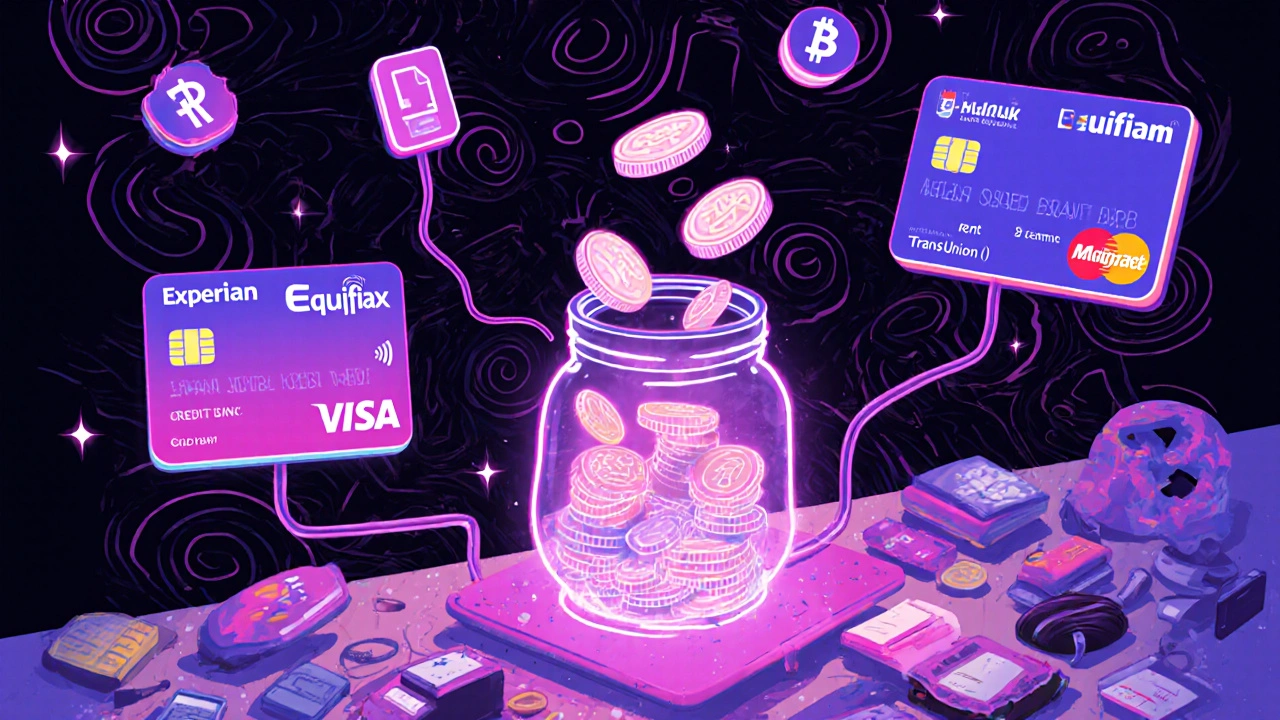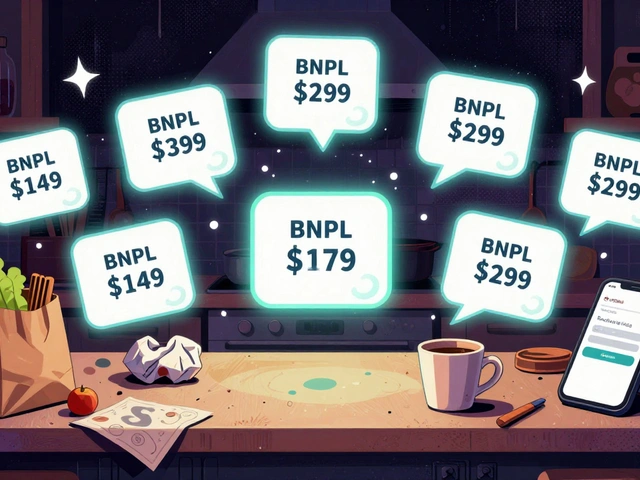Credit Building Calculator
How Credit Building Works
Digital banks track your financial behavior - on-time payments, low credit utilization, and consistent activity. This calculator shows how your actions impact your credit score using real-world data from the article.
Why Digital Banks Are Changing How You Build Credit
For years, building credit meant waiting weeks for a bank to review your application, sending paper documents, and hoping your rent or utility payments counted for something. Most traditional lenders ignored those payments entirely. Today, that’s outdated. Digital banks are rewriting the rules - and they’re doing it faster, smarter, and more fairly than ever before.
By 2025, over half of all new credit accounts are being opened through digital-only platforms. Why? Because they don’t just look at your credit score. They look at your behavior. Did you pay your phone bill on time for 12 months straight? Do you consistently deposit paychecks into your account? Did you avoid overdrafts for six months? Digital banks see those patterns - and they use them to decide if you’re creditworthy.
Traditional banks still rely on FICO 8, which only looks at five data points: payment history, credit utilization, length of credit history, credit mix, and new credit. Digital banks use up to 300 data points. That includes rent, streaming subscriptions, even how often you log into your app. It’s not magic. It’s machine learning trained on millions of real financial behaviors.
The Three Best Tools to Build Credit with Digital Banks
You don’t need a traditional credit card to start building credit. Here are the three most effective tools used by people who went from no score to 700+ in under a year.
1. Secured Credit Cards (No Credit Check Needed)
Chime’s Secured Credit Builder Card, launched in January 2022, requires only a $200 deposit. That deposit becomes your credit limit. You use it like any card - make purchases, pay it off monthly. Chime reports your payments to all three major bureaus: Experian, Equifax, and TransUnion. No hard pull. No annual fee. No interest if you pay on time.
Other options include the Credit Strong Secured Card (reports to all three bureaus) and the Self Visa Credit Builder Card (also reports to all three). The key? Make sure the card reports to all three bureaus. Many digital banks still only report to one. That cuts your credit-building speed in half.
2. Credit-Builder Loans (Pay Yourself to Build Credit)
Self Lender’s credit-builder loan works like this: you pay $500 upfront into a locked savings account. Then you make 12 monthly payments of $45. Each payment is reported to the bureaus. At the end of the term, you get your $500 back - plus interest earned. The APR is 7.99%, which is low for this type of product.
Why does this work? You’re not borrowing money. You’re proving you can make consistent payments. And because the money is held in a savings account, there’s no risk of overspending. This is the safest way to build credit if you’ve had past mistakes.
3. Hybrid Debit-Credit Cards (No Deposit, No Credit Check)
Current’s Credit Builder+ card, launched in April 2022, doesn’t require a deposit or a credit check. You pay a $5 monthly fee. Every time you use the card, Current reports your payment activity to Experian. It’s not a real credit card - it’s a debit card with credit reporting built in.
It’s not perfect. It only reports to one bureau. But if you’re starting from zero, it’s better than nothing. Use it for small, recurring bills - Netflix, Spotify, your gym membership. Pay it off every month. In six months, you’ll have a credit file. In 12, you might be eligible for a real credit card.
How Digital Banks See You Differently Than Traditional Banks
Traditional lenders look at your credit score like a final exam. Digital banks look at your financial behavior like a long-term project.
Let’s say you’re a freelancer. You earn $3,000 one month, $1,200 the next, $4,500 the next. A traditional bank sees inconsistent income and says no. A digital bank sees: you never overdrew your account. You paid your rent on time every month. You saved $800 in your savings account last quarter. You made 15 deposits over 12 months. That’s stability.
Upstart, a fintech lender that uses income volatility scoring, started reporting in February 2024 that their system reduced freelancer denials by 22%. That’s huge. It means people with irregular income - 30% of the U.S. workforce - now have a real shot at credit.
Even your digital footprint matters. If you use your phone to pay bills on time, manage your budget with an app, and avoid cash advances, digital banks notice. They don’t need a FICO score to know you’re responsible. They’ve seen millions of people like you.

What to Avoid: Hidden Fees and Reporting Gaps
Not all digital credit tools are created equal. Some are designed to trap you in fees, not help you build credit.
Watch out for:
- Annual fees disguised as "service charges" - Some cards charge $10-$25 per year and don’t tell you until after approval. Always read the fine print.
- Only reporting to one bureau - If a product only reports to Experian, your score won’t improve equally across all three. That limits your ability to qualify for mortgages or car loans later.
- High APR on credit-builder loans - Some charge 15% or more. Stick to products under 10% APR. Self Lender’s 7.99% is still the gold standard.
- Hard credit pulls - Avoid any product that requires a hard inquiry. That can drop your score 5-10 points right away. Look for "soft pull" or "no credit check" options.
Trustpilot reviews show 29% of users complain about hidden fees. Reddit threads are full of people shocked they were charged $10/month for a "free" credit builder. Do your homework before signing up.
How to Maximize Your Credit Growth (Step-by-Step Plan)
Here’s what a real 12-month plan looks like, based on Experian’s official guidance and real user results:
- Months 1-3: Get a secured card - Deposit $200-$500. Use it for one small recurring bill - like your phone or internet. Pay it off in full every month. Keep your balance under $50 on a $200 limit. That’s 25% utilization - ideal for scoring.
- Months 4-6: Add a credit-builder loan - Sign up for a $500-$1,000 loan with Self or Credit Strong. Make every payment on time. Set up autopay so you never miss one.
- Months 7-9: Add a hybrid card - Use Current’s Credit Builder+ or similar to report more activity. Pay it off weekly. This adds more data points to your file.
- Months 10-12: Check your reports - Go to AnnualCreditReport.com. Make sure all your payments are being reported correctly. If something’s missing, contact the bank and ask them to update the bureau.
People who follow this plan see an average score jump of 150-200 points in 12 months. One Credit Karma user went from 540 to 730 in 11 months using this exact method.

What’s Next: The Future of Digital Credit Building
The landscape is evolving fast. In May 2024, Experian launched Boost 2.0, which now includes 14 new utility providers - think gas, water, and even pet care payments. That means your on-time rent and internet payments could soon count more than ever.
The CFPB is expected to release new rules in 2025 that will force digital banks to standardize how they report alternative data. That means more transparency, fewer hidden fees, and better accuracy.
By 2028, Goldman Sachs predicts 73% of all credit building will happen through digital channels. That’s not a guess - it’s based on current growth trends. The subprime lending market, which digital banks now control 34% of, is projected to grow to $120 billion by 2027.
But there’s a warning. The Federal Reserve’s August 2024 paper found that algorithmic lending can shrink by 15-20% during economic downturns. That’s because these models rely on stable income patterns. If you lose your job, your credit score could drop faster than with a traditional lender.
That’s why the best strategy is simple: build credit slowly, consistently, and with multiple tools. Don’t rely on just one product. Use a secured card, a credit-builder loan, and a hybrid card together. That way, even if one system changes, your credit file stays strong.
Frequently Asked Questions
Can I build credit with a digital bank if I have no credit history?
Yes. Digital banks are designed for people with no credit history. Secured credit cards, credit-builder loans, and hybrid debit cards don’t require a credit check. They use your banking behavior - like on-time deposits and bill payments - to create a credit file from scratch. Many users go from no score to 600+ in under six months.
Do digital banks report to all three credit bureaus?
Not all of them. Some only report to Experian. Always check before signing up. The best products - like Chime’s Secured Card and Self Lender - report to all three: Experian, Equifax, and TransUnion. If a product only reports to one bureau, your credit growth will be slower and less effective.
Are credit-builder loans worth it?
Yes, if you choose the right one. Self Lender’s loan at 7.99% APR is low-cost and reports to all three bureaus. You pay $500 upfront, make 12 monthly payments, and get your money back with interest. It’s not a loan - it’s a savings plan with credit reporting. It’s one of the safest, most effective ways to build credit from zero.
What’s the fastest way to raise my credit score with a digital bank?
Use a secured credit card with a $200 deposit and keep your balance under $50. Pay it off every month. That’s 25% utilization - the sweet spot for FICO scoring. Add a credit-builder loan and make every payment on time. Within six months, you’ll see a 100+ point jump. Speed comes from consistency, not big balances.
Can I use a digital bank to build business credit?
Most digital banks focus on personal credit. For business credit, you’ll still need traditional lenders or platforms like Nav or Dun & Bradstreet. However, some digital banks like Mercury and Brex offer business credit cards that report to commercial bureaus. These are better suited for established businesses, not startups with no credit history.
Next Steps: What to Do Today
Don’t wait for the perfect product. Start now.
- Go to Chime’s website and apply for their Secured Credit Builder Card - it takes 3 minutes and has no hard pull.
- Check if your rent is being reported through Experian Boost. If not, sign up for free.
- Set up autopay for one small recurring bill on your current account. Pay it on time every month.
- Check your credit report at AnnualCreditReport.com. See if you already have a file - you might be closer than you think.
Building credit isn’t about having money. It’s about showing consistency. Digital banks make that possible - even if you’ve never had a credit card before. The tools are here. The data is there. You just need to start using them.






Comments
OMG I literally went from 520 to 710 in 10 months using Chime + Self Lender. No joke. I was skeptical as hell until I saw my Experian report light up like a Christmas tree. The hybrid card? Game-changer for rent reporting. I linked my Netflix and Spotify - turns out they count now. Also, stop falling for those ‘free’ cards with $15/month ‘service fees’ - I got burned once, never again. Build slow, build smart, don’t let fintech hustle you.
PS: If you’re on a budget, use the $200 secured card for groceries only. Pay it off the day after payday. Your utilization stays under 20% and your score rockets. Trust me, I’m not a financial guru - just someone who finally got out of credit purgatory.
This article is technically accurate but dangerously incomplete. You mention ‘300 data points’ as if it’s some revolutionary breakthrough - it’s not. It’s surveillance capitalism dressed up as financial inclusion. Your streaming habits, app logins, and payment latency are being monetized by algorithms trained on marginalized communities’ behavioral patterns. The CFPB’s upcoming rules? A band-aid. The Federal Reserve’s 2024 paper warned of algorithmic contraction during downturns - and yet, no one is talking about the ethical implications.
Furthermore, reporting to only one bureau is not ‘better than nothing’ - it’s predatory. It creates a two-tiered credit system: those who can afford to use all three reporting tools, and those stuck with Experian-only fluff. And don’t get me started on ‘hybrid debit cards’ - they’re not credit-building tools, they’re fee-generating traps with a shiny label. If you’re going to promote this, at least acknowledge the systemic exploitation beneath the UI.
Also, ‘no hard pull’ is a marketing lie. The underlying issuer still performs a soft pull, and if you default, it becomes a hard pull retroactively. Read the T&Cs. I did. You should too.
It is truly remarkable how the digital transformation of credit building has opened doors for so many who were previously excluded from the financial system - yet, I find myself reflecting deeply on the philosophical implications of this shift. We are no longer judged by our formal financial history, but by our digital footprints - our consistency in paying for streaming services, our ability to maintain a steady deposit pattern, even our frequency of app usage. Is this not a new form of moral evaluation, encoded in machine learning models?
Once, credit was about trust - now, it is about data fidelity. And while this may seem fairer on the surface, what happens when one’s life circumstances change - when illness, job loss, or caregiving disrupts the algorithm’s notion of ‘stability’? The system does not forgive, it only observes. And if you falter, your score collapses faster than a house of cards in a storm.
Yet, I remain an optimist. For every exploitative fee structure, there are individuals like Laura who have clawed their way out of credit darkness. For every algorithmic bias, there are regulators like the CFPB pushing for transparency. Perhaps this is not the end of financial justice - but its beginning. We must demand not just access, but dignity. Not just scores, but understanding. Let us use these tools - yes - but let us also question them, refine them, and humanize them. After all, credit is not a number. It is a story. And every story deserves to be told fairly.
For those starting out: begin with one tool. One payment. One month of consistency. That is your foundation. The rest will follow - not because the algorithm loves you, but because you have shown up, again and again, even when no one was watching.